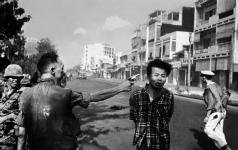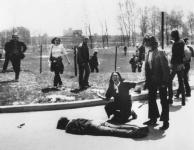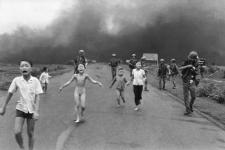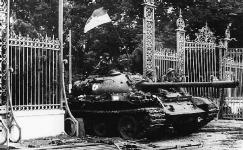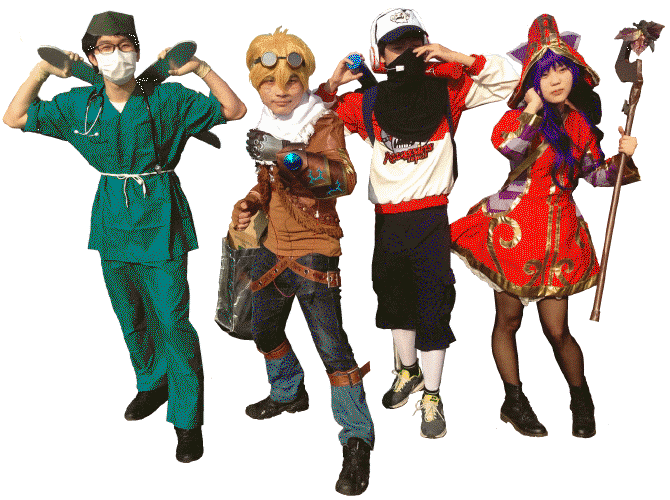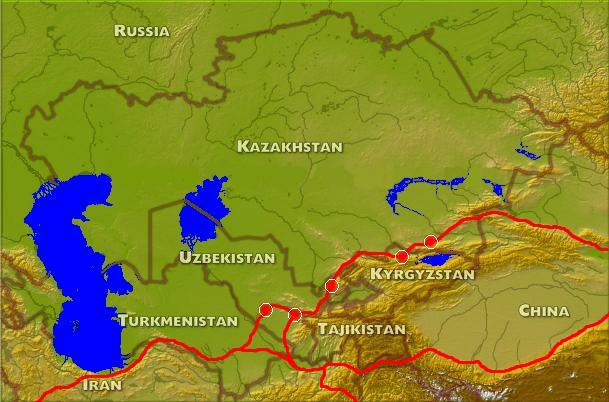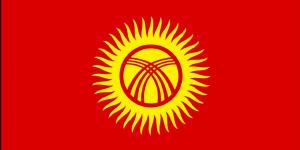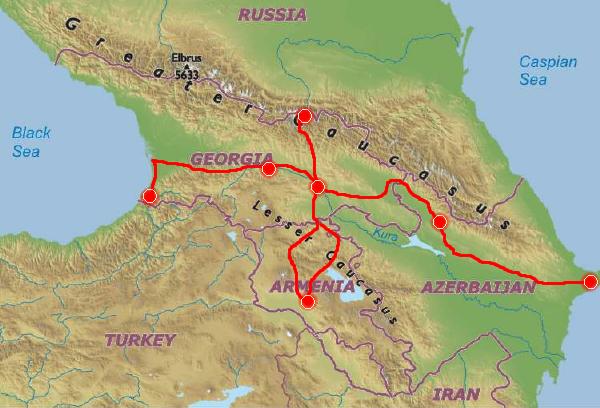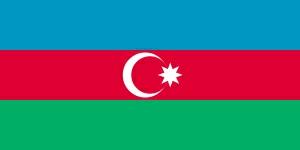October 18 − Greetings from Georgia (the Republic of)
One can make a career and a life by saying "yes" to opportunities that look like fun and/or a challenge.
Saying "yes" has allowed me to
work on the Apollo missions,
search for the end of the San Andreas fault,
train an elephant,
ride a Harley across Australia,
travel to unusual places, and
meet interesting people.
Three months ago, on the slopes of Mount Ararat in Turkey,
I bumped into an old friend who offered me an apartment in Batumi, Georgia.
48 hours later, I happened across a band of Georgian teachers, dancing and drinking in the Kaçkar Mountains,
who invited me to come to Batumi to teach English.
It was easy to say "yes" to this opportunity − even easier when I learned that I could walk from the apartment to the school.
So, I bought a one-way ticket to Batumi and
arrived in this marvelous place 3 days ago.
For comparison,
The Republic of Georgia is half the size and half the population
of the US state of the same name.
Georgia (the country) has only been independent from Russia since 1991,
but its history goes back thousands of years.
|
|
Batumi is a manageable city with a population of about 120,000,
sandwiched between stony Black Sea beaches and misty hills
full of parks, nature trails and gardens.
Batumi is a good base for exploring the other regions south of the Caucasus Mountains.
|

|

|
Architecturally, Batumi is an amusing and colorful mix of the old and the new.
The city experienced a bulding boom during the past decade
as part of its development as a summer holiday destination.
Yet, the city has preserved its fin-de-siècle elegance from its original boom time a century ago
when it was a major Black Sea shipping port.
Mostly, I'm just enjoying walking around in the sunshine smelling the sea breezes.
The trees are still green here.
Autumn hasn't come to Batumi yet.
|
|
Here's the view from the balcony of my apartment.
Gorki Street is lined with shops and restaurants,
and noisy with cars and mini-buses 20 hours a day.
I'm glad to be on the 4th floor, above all the traffic.
It's convenient to be right in the middle of town.
Everything I need is a short walk from my front door.
|

|

|
Behind my apartment is Nurigheli Lake, which is a peaceful place for a morning stroll.
There're several playgrounds, a zoo, and a dolphinarium around the perimeter of the lake.
The Black Sea is 100 meters to the left of this photo.
|
|
This is Tornike.
He's a 23-year-old artist.
He speaks English, having spent 2 years at university in London.
He manages my apartment.
My arrival and first few days were easy thanks to him.
He met my airplane last Thursday
and helped me find all the essentials for getting setup.
Over lunch, he gave me a summary of the social, economic and political situation in his country.
Life is getting better here, but there are still major concerns.
Tornike sells his ceramics and oil paintings at cafés and exhibitions.
He has traveled to Russia and Turkey a few times.
He hopes to leave Georgia some day and to move to western Europe.
He believes that his art will be more appreciated and find a better market there than in Batumi.
|

|

|
One of the best reasons to travel is to eat foods that you can't find at home.
Here's the first real meal I had in Batumi.
This is a warm eggplant salad.
I'm told this is a traditional Georgian dish.
I have no idea what spices were in this,
but it was delicious.
(Tornike opted for the club sandwich and Coke.)
The fresh squeezed lemon juice still had the seeds and pulp in it.
|
|
I'm often asked if I get tired of traveling.
One of the things that can make traveling tiresome is carrying a lot of luggage.
Most tourists burden themselves with 3 or 4 times more stuff than they actually need.
Not me.
I leave behind everything that I might need because,
by definition, if I might need something, then I might not need it.
Why carry something that's not needed?
If I need something I don't have, I buy it.
Shopping in foreign countries is a great way to experience the local culture and to see how business is done.
It rains hard in Georgia, but
did I pack an umbrella? No.
Today, I paid $8 for a 16-spine, black and plaid umbrella with a wooden handle.
I like supporting the local economy.
When I walk down the street with my new Georgian umbrella, I look less like a tourist and more like someone who lives here.
When I leave Georgia, I'll donate my umbrella to someone who doesn't have one.
|

|
|
Shown above is all that I have,
with the exception of the clothes I wear and
the camera with which I took this photo.
Be a minimalist.
Your bag will never get lost.
You'll breeze through customs.
Little luggage makes travel fun.
|
October 25 − My first week of school
This is the end of my first week of school.
I work afternoons from 1:00 to 5:00pm at a large public elementary school.
I've been teaching English in the 1st, 2nd, 4th, 5th and 8th grades.
During this first week,
I've become acquainted with the materials used,
the method of instruction
and, of course, the teachers and students.
|
|
I teach at Batumi's Public School #9.
About 1500 students, from 1st to 12th grade, attend classes here.
This building was built by the Russian government about 30 years ago.
It could use some paint.
A few windows need to be replaced.
The doors are out of alignment.
The blackboards are chipped and cracked.
The desks and chairs are well-worn.
But the school is a solid structure still serving the purpose for which it was built.
|

|

|
In Georgia, English is a required course from 1st grade all the way through high school.
The students learn to read and write English at a fairly aggressive pace.
By the 8th grade, their grammar and spelling is almost equivalent to that of American students.
Before my arrival, there were no native English speakers at School #9.
So, one of my jobs here is to help the students − and the teachers − with pronunciation.
The other way that I'll make myself useful is to share teaching techniques and methods with the Georgian teachers.
These are my 4th grade students.
They are a delightfully happy and enthusiastic bunch.
If there were any doubt in my mind about what a Caucasian person looks like, now I know.
|
|
This is Magda Kuridze and her husband Olegi.
Magda and I met in July
when she and the other teachers from School #9 took a field trip to the Kaçkar Mountains of Turkey.
That's when Magda and her colleagues invited me to come to Batumi to assist at their school.
During my first week of classes, I've been observing and co-teaching with Magda.
Next week, I'll start working with the other English teachers.
|

|

|
When I'm not teaching, I enjoy walking around Batumi marveling at its creative architecture.
Here's a photo of one of the wackier buildings.
It's a scale replica of America's White House, turned upside down.
It's a fully-functioning and fashionable restaurant.
The upside-down theme is repeated inside the building,
with upside down staircases, decorations and even bathroom fixtures.
|
|
Many of Batumi's fin-de-siècle buildings have been well-preserved.
Downtown Batumi has
cobble-stone streets,
electrified gas lamps,
art deco clock towers,
old cathedrals,
charming plazas with sidewalk cafés,
and
outdoor entertainment.
In the summer, this quaint downtown is flooded with tourists.
October is the off-season.
There's no trouble finding a table with a view this month.
|

|

|
Batumi is a beach town on the eastern shore of the Black Sea.
Although it's late October
and we're at 41 degrees north,
the weather has been remarkably warm.
Temperatures this week were in the mid-70s.
The maples and oak trees haven't begun to show their fall colors yet.
In the mornings, I go jogging on the beach.
People are still swimming here.
And yet, this is the former USSR?!
I took this photo Thursday morning on my walk to school.
From the streets of Batumi,
one can look north and east to the Caucasus Mountains and see that the mountains are full of snow.
It's remarkable to see these threatening, jagged, white peaks towering above the palm trees.
Warm as it is, winter can't be far away.
|
|
In the evenings after a day of teaching,
I walk to nearby restaurants to sample the local fare.
This is khachapuri, one of Georgia's national dishes.
It's a boat-shaped bowl of bread filled with melted cheese, egg and butter.
It goes well with beer.
Yum!
|

|
November 1 − An educational experience
People often ask me why I travel.
I travel because I like to learn new things.
If I stay in one place for too long, I get comfortable ... and lazy.
Traveling to places I haven't been before forces me to
learn languages,
adapt to new cultures,
accept different points of view, and
in general challenge myself.
Living in Batumi is a pleasant challenge.
I'm enjoying a modest teaching schedule with about 20 classes per week.
My school needs repairs and resources are limited.
But the staff is dedicated and the children are enthusiastic and quite bright, too.
|
|
One of the best parts of my day is my walk home from school.
Here's the Black Sea on a calm day.
I'd been warned that October is the rainy season.
What this means is that there are 2-3 days per week of rain.
The rest of the days are stunningly beautiful, with clear skies and daytime highs in the 60s.
Great weather for walks − or runs − on the beach.
|

|

|
Exploring a new city starts with one's immediate neighborhood.
Walking out of my apartment, turning right and walking two blocks
brings me to a small farmer's market that happens every day, rain or shine.
The produce is restocked every morning.
Judging by the spots on the vegetables
and the sweetness of the fruits,
I suspect that everything is local and organic.
Delicious, too.
No doubt about that.
The usual veggies, like tomatoes, cucumbers and lettuce, are available, of course.
Persimmons, squash, pumpkins, apples and tangerines are in season now.
|
|
If I walk out of my apartment, turn left and walk two blocks,
I come to one of Batumi's top tourist attractions:
The Dolphinarium.
There's an entertaining show every afternoon.
From my ringside seat,
it looked as though the dolphins were enjoying putting on their show.
I was impressed.
A bargain for eight bucks.
|

|

|
This is Diana Jakeli.
She sits on the first row of my 5th grade English class.
Georgian children don't know about Halloween.
In conservative Orthodox Georgia,
Halloween is not celebrated because it's thought to involve Satanism.
Yesterday, I told my students about Halloween in America.
I showed photos of homes decorated with pumpkins and ghosts,
and children in costumes going trick-or-treating.
The students were astonished by this bizarre American custom.
It was the first time that they'd ever seen a real jack o'lantern.
They all wanted to touch it and have their photos taken with it.
|
|
And now for the educational challenge of my week:
Learning the Georgian alphabet,
shown here with the vowels in red.
I'm using flash cards to learn these letters.
At least there are only 33 − so it's easier than Japanese.
I'm also learning to speak Georgian.
I figure that if I'm going to ask my 1st graders to learn to count from 1 to 10 in English,
then I'd better learn to count in Georgian.
The sound of this language takes some getting used to.
There aren't very many vowels.
For example, the word for the number 9 is TSKHRA.
That's the sort of word I'd like to be able to use when playing Scrabble.
|

|

|
One of the other reasons I love to travel is to try new foods.
The dumplings shown here are called KHINKALI.
The spicy beef and pork filling is uncooked when the khinkali is assembled.
So when cooked, the juices of the meat are trapped inside the dumpling.
Khinkali is eaten by hand.
On the first bite,
one must suck out the juices in order to prevent the dumpling from bursting.
The rolled bread at the top contains kabob,
which gets lathered in a sauce made from tomatoes and peppers.
Hidden beneath the onion rings are spicy pork ribs.
|
|
Georgians are generous and hospitable.
This week, I was invited to 3 different homes for meals.
Each time, my hosts insisted that they weren't serving me anything other than their normal, every-day meals.
Here's desert at a colleague's apartment.
The black round nuggets are walnuts,
which were picked early in the season and then soaked in honey for a few months.
There are two types of persimmons shown here.
The yellow one is crisp like an apple.
The red one is so soft that it can be eaten with a spoon.
At the farmer's market, persimmons cost about 15 cents each.
I'll be having one for breakfast every day.
|

|
November 17 − The Secret to Happiness
Last week, The Wall Street Journal published
an article
affirming what I've come to believe about money, travel and material possessions.
If you want to be happy, you should do three things:
- Achieve financial security.
This doesn't mean being a millionaire.
It simply means earning more than you spend.
Nothing more.
- Buy experiences instead of things.
Owning lots of pretty things might allow you to keep up with the Joneses,
but maintaining those material possessions will consume your time − which is more valuable than money.
- Do things for others.
Use your time and money to benefit others instead of yourself.
Walking out of a store with a new pair of shoes won't make you smile as much as
giving a pair of shoes to a child who has never worn shoes before.
I follow the blog of a fellow traveler named
Chris Guillebeau.
When he started his travels,
Chris calculated that visiting 100 countries would cost about the same as a new SUV.
He didn't buy the SUV, of course.
Instead, he hit the road and his travels became a life-changing experience.
Would driving an SUV for a few years have done the same for him?
No way.
My travel budget is $100/day, and that includes everything,
such as visas, health insurance, airplane tickets and my storage locker in San Francisco.
Naturally, some countries − like Sweden − are more expensive than others − like Cuba.
But my long-term average is about $100/day.
If you do the math, that works out to be only $36k/year −
which is less than the
average US net income.
To travel forever, all I have to do is find a way to make about $36k per year.
I can do this thanks to a few clients in California
and a long-term contract with the Navy.
Thus, I have all the time in the world,
no possessions to burden me,
and cash leftover to give to those in need.
It's not about money. It's what you do with your money − and your time.
|
|
I spend six days a week at Batumi's Public School #9.
Here's a photo of a typical classroom.
There are 26 first graders in this class.
I'm the only native English speaker at this school.
I read aloud to the students and
help them with their pronunciation.
Two weeks ago, the first graders learned their numbers from 1 to 10.
Last week, they learned the words for members of their family,
such mother, father, sister, brother, grandmother and grandfather.
Georgia is a very traditional, family-oriented, Orthodox Christian culture.
Young women live with their families until they're married,
at which time they usually move into their husband's home.
Everyone has children.
Divorce is rare.
So, learning the English words for their family members was natural for these children.
|

|

|
This is Mrs. Guguli Pataraya,
one of my colleagues.
She's 87 years old and
has been teaching at my school for more than 60 years.
(No one knows exactly how long she's been teaching here.)
Guguli wears black because she's a widow.
She has one unmarried son who lives with her.
She has no grandchildren.
She treats her students like her grandchildren, and they absolutely love her.
Guguli is revered by all the other teachers.
In the Georgian elementary school system,
teachers keep the same students for four consecutive years from 1st through 4th grade.
Then, the teachers start over with a new group of students.
I like this teaching system because it gives the students and the teachers four years to get to know each other.
The students who have Guguli consider themselves very lucky.
Although Guguli speaks no English, she knows exactly what I'm saying.
|
|
Being by the sea helps moderate Batumi's temperature.
Even in mid-November,
daytime highs are in the 60s.
At night, temperatures drop into the upper 40s.
The mountains rise steeply behind the city.
When it rains in town, the mountains get snow.
A lot of Batumi consists of old Russian-built apartments
in need of new roofs and fresh paint.
I'm told that life in these apartments is comfortable and social.
Neighbors drop in on each other for coffee without invitation.
You can buy a 3-room apartment in Batumi for about $50,000.
|

|

|
Georgian food continues to delight.
Not all Georgian food is comprised of meat, eggs, cheese, butter and bread.
Here are two vegetarian appetizers:
- The three whitish squares on the left are
Badrijani Nigvzit:
Fried eggplant stuffed with spiced walnut paste.
- The larger patty on the right is
Mtsvane Pkhali:
Minced cabbage, eggplant, spinach, beans and beets,
combined with ground walnuts, vinegar, onions, garlic, and herbs.
Both appetizers are garnished with pomegranite seeds.
Yum!
(For you foodies, click on the links above to see the recipes.)
|
|
Archaeologists have determined that the
world's first wine production
started here in Georgia about 8000 years ago.
Wow! No wonder the local wine here is fantastic.
Not very expensive either.
On the first floor of my building is a woman with a small store in which she has several large barrels of wine.
I visit her every few days with an empty wine bottle,
which she refills for about $4.
|

|

|
I walk home from school every afternoon along the beach.
Here's a fishing boat coming home with the day's catch −
and a flock of gulls following close behind hoping for dinner.
The snowy mountains high in the background are the Caucasus, about 200km north of Batumi.
The 2014 Winter Olympics were held last February on the other side of these mountains in Sochi, Russia.
|
|
Here's the full moon on November 6th,
with the nearby hills dusted with fresh snow.
With the Ukraine-Russia conflict to the north and the terrible plight of the Kurdish refugees to the south,
it's remarkable how happy and peaceful this little country is.
I've decided to stay here for another month.

|

|
November 28 − Health & Happiness
Many of you responded to my last blog about money and happiness.
A friend reminded me that I forgot an essential ingredient for a happy life.
He wrote ...
If you don't have your health, everything else ain't worth spit.
This is so true.
In addition to good health,
close personal relationships are also part of being happy.
In honor of Thanksgiving,
I'd like to say thank you
to all of you wonderful family and friends back home.
You make what I do worthwhile.
Thanks for all the emails!
|
|
The weather here in Batumi continues to be mild.
So, I've spent time exploring the sites near here.
Here's what the coastline of the Black Sea looks like north of town.
I was surprised to find it so rugged and lush.
Yes, that's a railroad that runs along the shore.
The tracks continue to the oil fields of Azerbaijan.
|

|

|
This photo was taken in
Batumi's Botanical Garden,
a public park created about a century ago to showcase plants from around the world.
It's a huge area − almost 300 acres −
of forests, waterfalls, pathways and vistas.
Lovely for a walk or a picnic.
|
|
Just south of town is
Gonio-Apsaros,
the oldest fortress in Georgia.
Archeologists have found artifacts and stone walls
dating to the XV-XVII centuries BC.
According to the Greek myth about the Argonauts,
this was the place where Apsyrtus (King Aet’s son killed by Jason) was buried.
Later, when Batumi was the eastern frontier of the Roman Empire,
Roman troops were stationed here.
Having visited Roman ruins in Morocco in February,
I can now say I've traveled from one end of the Roman Empire to the other in 2014.
|

|

|
The son of one of the teachers at my school got married last weekend.
Here's the car, decorated for the drive from the ceremony to the reception.
|
|
The wedding reception was a feast.
Anticipating that I'd be well-fed, I skipped lunch that day
− and quickly ate my fill of all these delicious treats.
What I didn't realize is that the food shown here is just the hors d'oeuvres!
The meal went on for hours and the plates kept coming.
When the boar's head was finally served, I only had room for a few bites.
|

|

|
During our lavish meal,
we were entertained by a number of shows.
including dancing Cossacks doing traditional Georgian dances.
Wow!
Going to a wedding is one of the best ways to experience a foreign culture.
I'm told that this reception dinner was nothing out of the ordinary:
"Dis eez like all ov our veddings.
Dey are alvays like dees.
Have some more vine.
Gaumarjos!!!"
|
|
On a sad note, a dear friend died at her home in Connecticut last week.
Nancy was lovely inside and out.
She was an inspired musician.
Her sweet spirit,
constant smile and
great conversation
touched everyone she met.
Our lives are better for having Nancy come into it.
She will be remembered fondly
in our thoughts and prayers.
Nancy was only 56 years old,
but her chronic illnesses finally got the best of her −
which underscores the point made at the top of this post:
Health is everything!
|

|
|
So, please let's all take good care of ourselves and each other.
Appreciate our delicate existences.
Life seems more precious in the face of such an event.
Let's be kinder to each other.
Have a happy, healthy Thanksgiving.
|
December 17 − Moving on
Batumi has been my home for two months.
I could write pages about what a wonderful place Batumi is with its ...
- Mild climate
- Low cost of living
- Colorful traditions
- Delicious food and wine
- Easy living beside the Black Sea
- Generous, hospitable and warm-hearted people
This little town is such a welcoming place, I could consider living here.
But if I did, I wouldn't see the rest of the world.
So, I'm writing this blog at the airport.
|
|
Since my last posting,
I've been involved with performing arts.
Here's Batumi's Performing Arts Center −
a handsome bit of architecture
blending modern materials into a classical design
with arches, pillars and frescoed ceilings.
I was here twice last week,
once to hear Batumi's symphony orchestra play Beethoven and Mozart.
My second visit was for a cultural variety show
featuring local musicians, singers and dancers
performing everything from opera
to traditional Georgian folk dances
and rock and roll.
|

|

|
Not far from my apartment is Batumi's Drama Theatre,
a classic XVIII century theatre.
There's an acting troop that performs here about 3-4 times a week,
with a different show every couple of nights.
The acting is first rate and the tickets average about $4 each for great seats.
The performing arts must be heavily subsidized by the government.
|
|
Here's the interior of the Batumi Drama Theatre.
Like all good theatres,
it's in a fashionable neighborhood
filled with cafes and restaurants that stay open late
for the patrons to have a nightcap after the show.
It may not be Broadway, but it's an inexpensive and intimate alterative.
I should mention that all of the performances are in Georgian.
I don't speak much Georgian (yet!) and can't understand the dialogues word for word.
So before each play, I read the plot summary on-line and,
when possible, view a performance in English on youtube.
Knowing Georgian isn't necessary to following the story because
the acting at Batumi's theatre is so convincing.
|

|

|
Meanwhile, I've been involved in my own theatre project.
I wrote and co-directed the 4th grade play at Public School #9.
Because the actors were from one of my English classes,
this play was in English,
including musical numbers
from Crosby, Stills & Nash and Michael Jackson.
The audience was parents and faculty, of course.
They were amazed and delighted
to see their children speaking and singing in English.
This was the first time that this school has done a play.
They say it's going to become an annual tradition.
|
|
This is Anri Gabaidze,
who played the role of Mr. Jolly.
If he looks a little subdued or nervous here,
it's because this photo was taken before going on stage.
Once on stage,
he displayed his usual good humor and exuberance.
I was impressed by this group of 9-year-olds.
After three weeks of chaotic rehearsals,
their performance went off without a hitch.
Amazing!
Working closely with these students for many afternoons
was a unique opportunity to get to know what Georgian children are like.
Like all kids of this age, they're full of energy.
But unlike most kids of the same age,
these Georgian children have humility and determination.
|

|

|
Every good show deserves a cast party.
Here we are in the 4th grade homeroom after the performance,
congratulating ourselves on an excellent show.
I introduced Public School #9 to another first last week:
A Spelling Bee,
for 6th, 7th and 8th graders.
The final round was fierce competition
in which the students battled it out with words like
"chimney" and "neighbor".
The conclusion was dramatic.
Now that School #9 knows what a Spelling Bee is,
this too may become an annual tradition.
|
|
Before I came here, I never expected Batumi to be such a lovely place.
I've been blessed by unseasonably warm weather.
I was still having lunch on the weekends at outdoor cafes on the beach.
This really has been a lovely place to live for the past two months.
But if I stay any longer, I'll start putting down roots.
So, it's time to move on.
My next stop is Tel Aviv.
|

|
|































































































